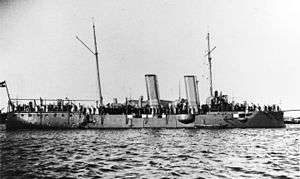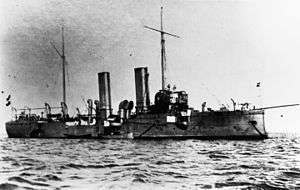Panther-class cruiser
 Panther in port, date unknown | |
| Class overview | |
|---|---|
| Builders: | Stabilimento Tecnico Triestino, Trieste |
| Operators: |
|
| Preceded by: | Zara class |
| Succeeded by: | SMS Tiger |
| Built: | 1884–1886 |
| In commission: | 1885–1920 |
| Completed: | 2 |
| Scrapped: | 2 |
| General characteristics | |
| Displacement: | 1,557 t (1,532 long tons; 1,716 short tons) |
| Length: | 73.19 m (240 ft 1 in) |
| Beam: | 10.39 m (34 ft 1 in) |
| Draft: | 4.28 m (14 ft 1 in) |
| Installed power: | 5,940 to 6,380 indicated horsepower (4,430 to 4,760 kW) |
| Propulsion: | 2 × compound steam engines |
| Speed: | 18.4 to 18.7 knots (34.1 to 34.6 km/h; 21.2 to 21.5 mph) |
| Crew: | 186 |
| Armament: |
|
| Armor: | Deck: 12 mm (0.47 in) |
The Panther-class consisted of two cruisers, Panther and Leopard, built for the Austro-Hungarian Navy in the 1880s.
Design
The Austro-Hungarian Navy Commander (Marinekommandant), Vice Admiral Maximilian Daublebsky von Sterneck, outlined in a memorandum of 8 September 1884 the requirements for a torpedo ram cruiser. Such a vessel should have a reinforced bow for ramming as well as torpedoes for attacks on larger warships. The cruisers would also be small and fast enough to undertake patrol and reconnaissance duties.[1] The ships were ordered from the British Armstrong shipyard in part because Armstrong could build the ships more cheaply, but also to gain experience building modern small cruisers. In fact, Panther and Leopard provided the basis for the follow-on design, SMS Tiger, which was a slightly enlarged version of the earlier ships.[2][3] They were originally classified as "torpedo ships" (Torpedoschiff), equivalent of a torpedo cruiser in other navies. In 1903 they were reclassified as 3rd Class Cruisers, then in 1909 as small cruisers (Kleine Kreuzer).[1]
Characteristics
The Panther-class cruisers were 69 meters (226 ft 5 in) long between perpendiculars, 71.38 m (234 ft 2 in) long at the waterline, and 73.19 m (240 ft 1 in) long overall. They had a beam of 10.39 m (34 ft 1 in) and a draft of 4.28 m (14 ft 1 in). They displaced 1,557 t (1,532 long tons; 1,716 short tons). Their crew numbered 186 officers and men, though this later increased to 198.[4][5]
The ships' propulsion system consisted of a pair of two-cylinder vertical compound steam engines. Steam was provided by six cylindrical fire-tube boilers that were trunked into two funnels. The engines were rated at 6,000 indicated horsepower (4,500 kW) for a top speed of 18 knots (33 km/h; 21 mph). On trials, Panther reached a speed of 18.4 knots (34.1 km/h; 21.2 mph) from 5,940 ihp (4,430 kW), slightly slower than her sister ship Leopard, which made 18.7 knots (34.6 km/h; 21.5 mph) from 6,380 ihp (4,760 kW). The ships had a cruising radius of 2,800 nautical miles (5,200 km; 3,200 mi) at a more economical speed of 10 knots (19 km/h; 12 mph).[4][5] Unlike earlier cruising ships of the Austro-Hungarian Navy, Panther and Lussin did not carry a sailing rig to supplement their steam engines.[3]
Panther and Leopard were armed with two 12-centimeter (4.7 in) 35-caliber (cal.) guns manufactured by Krupp in single mounts, which were sponsoned abreast of the funnels. These were supported by a battery of four 47 mm (1.9 in) quick-firing guns and six 47 mm revolver cannon. They were also armed with four 14 in (360 mm) torpedo tubes. The torpedo tubes were located singly, in the bow, stern, and at either beam. In June 1909, Panther was rearmed with four 66 mm (2.6 in) 45-cal. guns and ten 47 mm QF guns, along with her original torpedo tubes. Leopard was similarly reequipped the following year. The Panther-class ships were protected with a thin 12 mm (0.47 in) armored deck. The hatches above the engine room were 50 mm (2.0 in) thick.[4][5]
Ships
| Ship | Builder[4] | Laid down[4] | Launched[4] | Completed[4] |
|---|---|---|---|---|
| SMS Panther | Armstrong | 29 October 1884 | 13 June 1885 | 31 December 1885 |
| SMS Leopard | January 1885 | 10 September 1885 | 31 March 1886 |
Service history

Notes
References
- Gardiner, Robert, ed. (1979). Conway's All the World's Fighting Ships: 1860–1905. London: Conway Maritime Press. ISBN 0-85177-133-5.
- Greger, René (1976). Austro-Hungarian Warships of World War I. London: Ian Allan. ISBN 978-0-7110-0623-2.
- Sieche, Erwin (1996). Torpedoschiffe und Zerstörer der K. u. K. Marine. Wölfersheim-Berstadt: Podzun-Pallas-Verlag. ISBN 3-7909-0546-1.
- Sondhaus, Lawrence (1994). The Naval Policy of Austria-Hungary, 1867–1918. West Lafayette: Purdue University Press. ISBN 978-1-55753-034-9.